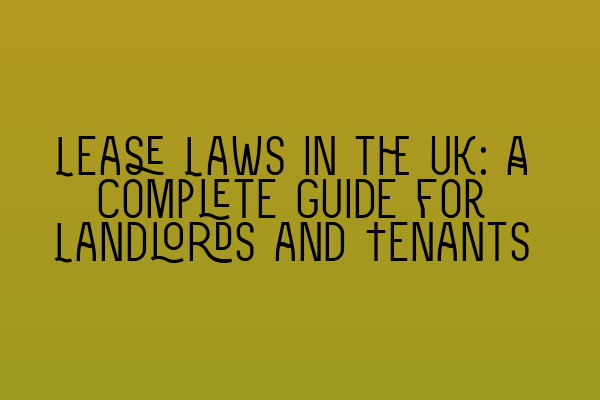Lease Laws in the UK: A Complete Guide for Landlords and Tenants
Lease laws are an essential aspect of property law in the UK. Whether you are a landlord or a tenant, understanding lease laws is crucial to ensure a smooth and legal tenancy. In this comprehensive guide, we will explore the key aspects of lease laws in the UK, providing you with a clear understanding of your rights and responsibilities.
1. What is a Lease?
A lease is a legally binding contract between a landlord and a tenant for the occupation of a property. It sets out the terms and conditions of the tenancy, including the rent, duration, responsibilities, and rights of both parties. The agreement is typically written, although oral agreements are also recognized but can be challenging to enforce.
2. Types of Leases
There are various types of leases in the UK, each with its own rules and regulations. Let’s take a closer look at the most common types:
a) Assured Shorthold Tenancy (AST)
AST is the most common type of residential tenancy. It provides tenants with a minimum term of six months, after which the tenancy becomes a periodic tenancy. ASTs give landlords the right to repossess the property after the fixed term, subject to certain legal requirements.
b) Periodic Tenancy
A periodic tenancy is a type of tenancy that runs from month to month or week to week, with no fixed end date. It continues until either party gives the appropriate notice to terminate the tenancy. Periodic tenancies often arise when an AST expires, and the tenant continues to occupy the property with the landlord’s consent.
c) Commercial Leases
Commercial leases are used for rental properties used for business purposes. They have different legal requirements compared to residential leases and often involve longer terms and more complex provisions. It is essential to seek legal advice when dealing with commercial leases.
3. Rights and Obligations of Landlords
Landlords have specific rights and obligations under lease laws in the UK. Here are the key points to consider:
a) Right to Rent
Landlords have the right to rent their property to tenants who have the legal right to reside in the UK. It is their responsibility to conduct appropriate checks to verify a tenant’s immigration status.
b) Deposits
Landlords must protect tenants’ deposits in a government-approved tenancy deposit protection scheme. Failure to do so may result in financial penalties and restrict the landlord’s ability to regain possession of the property.
c) Repairs and Maintenance
Landlords are responsible for ensuring the property is safe and habitable for tenants. This includes maintaining the structure, heating, plumbing, and electrical systems. Tenants have the right to request repairs, and landlords must respond within a reasonable timeframe.
4. Rights and Obligations of Tenants
Tenants also have specific rights and obligations under lease laws. Let’s explore some of the key points:
a) Right to Quiet Enjoyment
Tenants have the right to enjoy their rented property without disturbance from the landlord or other parties. Landlords must provide reasonable notice before entering the property unless it’s an emergency.
b) Rent Payments
Tenants are obliged to pay rent on time as agreed in the lease. Late rent payments may result in penalties, including eviction, so it’s crucial to fulfill this obligation promptly.
c) Care and Maintenance
Tenants are responsible for taking reasonable care of the property and notifying the landlord promptly of any necessary repairs or maintenance.
5. Termination of a Lease
Leases can be terminated in various ways, depending on the type of tenancy and the circumstances involved. Here are some common scenarios:
a) Tenant’s Notice
Tenants can terminate their lease by giving the appropriate notice as per the terms of the agreement. Typically, this involves providing one month’s notice in periodic tenancies or waiting until the fixed term ends in ASTs.
b) Landlord’s Notice
Landlords can terminate a tenancy by providing the appropriate notice in accordance with the law. This usually requires giving at least two months’ notice and following the correct legal procedure.
c) Mutual Agreement
In some cases, landlords and tenants may come to a mutual agreement to terminate the lease before the agreed-upon end date. This requires both parties to sign a new written agreement.
Understanding and complying with the process of lease termination is essential to avoid legal disputes and ensure a smooth transition.
Conclusion
Lease laws in the UK provide a framework for both landlords and tenants to operate within a secure legal environment. By understanding the rights and obligations outlined in a lease, both parties can ensure a fair and mutually beneficial tenancy. If you have any specific questions or concerns about lease laws, it is advisable to seek professional legal advice.
Related Articles:
